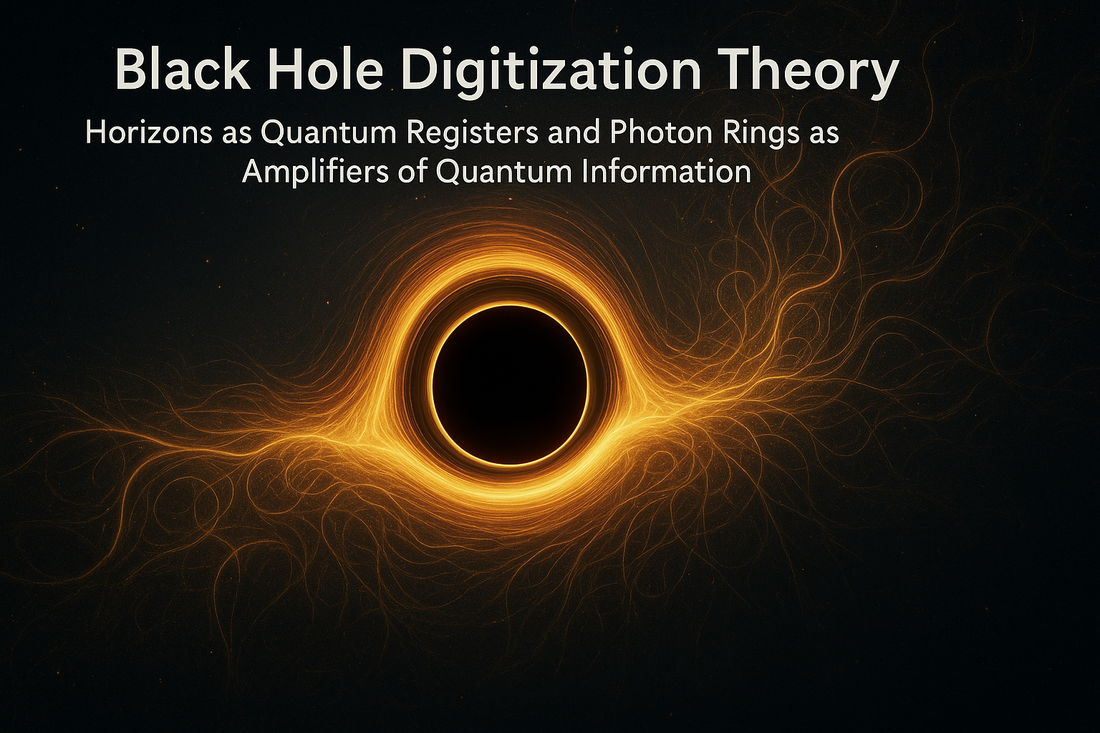Black holes sit at the confluence of thermodynamics, quantum information, and geometry. Entropy proportional to area, a temperature set by surface gravity, and the possibility of information loss forced theory to evolve: holography and modern Page-curve computations now suggest evaporation is unitary. We take a pragmatic, operational stance: a black hole is a quantum device with finite capacity, fast scrambling dynamics, and a physical read-out channel—Hawking quanta. We call this the Black Hole Digitization Theory (BHDT).
Black Hole Digitization Theory: Horizons as Quantum Registers and Photon Rings as Amplifiers of Quantum Information

Black Hole Digitization Theory: Horizons as Quantum Registers and Photon Rings as Amplifiers of Quantum Information
Black holes act as finite quantum registers (area-law capacity) that scramble, store, and slowly emit information via Hawking radiation.
Photon rings may amplify Planck-scale horizon microstructure (“spotting”) into observable signatures.
Holography, Page curve/islands, fast scrambling, soft hair, MERA fractality; observational focus on EHT & ringdowns.
Conceptual framework with testable implications; observational confirmation pending next-gen VLBI/GW data.
Contents
- Abstract
- 1. Introduction
- 2. Black holes as quantum registers
- 3. Massive quantum objects & gravity
- 4. Partial absorption & “spotting” at the edge
- 5. Amplification by photon orbits
- 6. Photon rings as quantum probes
- 7. Gedanken & analogue experiments
- 8. Fractal / multi-scale encoding
- 9. Cosmological extension
- 10. Open questions
- 11. Conclusion
- References
Abstract
We propose Black Hole Digitization Theory (BHDT): black holes are finite-capacity quantum information registers whose microstate dimension satisfies \( \log \dim \mathcal{H}_{\mathrm{BH}} = A/(4G\hbar) \). Infalling matter is converted to horizon degrees of freedom, rapidly scrambled, and gradually emitted in Hawking radiation that follows a unitary Page curve explained by quantum extremal surfaces (“islands”) and replica wormholes. We extend this with two observationally minded ideas: (i) near-horizon quantum microstructure can induce minute phase/Polarization irregularities (“spotting”) in photons that graze the horizon; (ii) unstable photon orbits act as amplifiers, so higher-order photon rings could magnify Planck-scale effects enough to become measurable in next-generation VLBI. We outline gedanken and analogue experiments (entangled “quantum pings” at horizons; BEC/optical analogues), relate BHDT to fast scrambling, soft hair, MERA fractality, and discuss cosmological implications wherein late-time Hawking radiation forms an informational “archive” that could seed a subsequent aeon in cyclic scenarios. We close with a checklist of ring-level signatures that could provide the first direct evidence of quantum gravity at horizons.
1. Introduction
Black holes sit at the confluence of thermodynamics, quantum information, and geometry. Entropy proportional to area, a temperature set by surface gravity, and the possibility of information loss forced theory to evolve: holography and modern Page-curve computations now suggest evaporation is unitary. We take a pragmatic, operational stance: a black hole is a quantum device with finite capacity, fast scrambling dynamics, and a physical read-out channel—Hawking quanta. We call this the Black Hole Digitization Theory (BHDT).
Building on this core, our extended discussion adds two layers aimed squarely at observation: (a) at quantum scales, wavepackets that skim the horizon can experience partial absorption, leaving the escaping part with tiny but principled distortions (phase or polarization) that manifest as spotting at the extreme edge; and (b) the photon sphere’s unstable orbits and repeated near-horizon passes provide a natural amplification mechanism for such microstructure, making photon rings the best current arena for horizon-scale quantum signatures.
2. Black holes as quantum registers
2.1 Area law as capacity
The Bekenstein–Hawking entropy, \(S_{\mathrm{BH}}=A/(4G\hbar)\), elevates area into an information-theoretic quantity. BHDT reads this literally: the horizon hosts a register with roughly one qubit per Planck area, up to subleading corrections. That makes the horizon a digital surface, where energy and information trade places through the first law \( dM = ( \kappa / 8\pi G )\, dA + \Omega\, dJ + \Phi\, dQ \).
2.2 Scrambling and mirroring
Black holes are conjectured fast scramblers, mixing infalling data across their dofs in time \( t_* \sim (\beta/2\pi)\ln S \). Post-Page, the Hayden–Preskill “mirror” picture implies that freshly injected information reappears rapidly within the outgoing quanta, albeit hidden behind daunting decoding complexity.
2.3 Holography and error correction
AdS/CFT and the Ryu–Takayanagi prescription tie bulk geometry to entanglement entropies. The interior is an encoded object reconstructed from boundary subregions—i.e., a quantum error-correcting code. Islands extend this control to evaporating black holes coupled to baths, recovering the unitary Page curve.
3. Massive quantum objects and the distortion of spacetime
A key conversational insight was that black holes are simultaneously maximally gravitational and genuinely quantum. They supply the cleanest example that quantum systems gravitate: a black hole’s state—finite, discrete, unitary— curves spacetime profoundly. The open question is not whether quantum objects distort spacetime (they do) but whether spacetime itself must be quantized to be consistent with superpositions of geometry. BHDT is compatible with a fully quantum gravity, while remaining practical in semi-classical regimes.
4. Partial absorption and “spotting” at the edge
Photons aren’t bullets; they are wavepackets. Near a horizon, mode-splitting means support can straddle the boundary. The escaping portion may carry minuscule, structured distortions (phase, polarization) arising from interactions with horizon microstates. Aggregated across many geodesics, this could appear as spotting—a speckle-like irregularity—precisely where the photon ring forms.
5. Amplification by unstable photon orbits
5.1 Multiple passes as gain
The photon sphere at \(r=3GM/c^2\) (Schwarzschild) hosts unstable null geodesics. Trajectories with impact parameter near critical can execute multiple orbits before escaping. Each loop re-samples the near-horizon region, compounding tiny phase shifts—an effective gain.
5.2 Chaotic sensitivity
Nearby geodesics diverge exponentially. Chaotic sensitivity can magnify microscopic horizon jitter into macroscopic differences in exit angle/phase, potentially imprinting measurable irregularities in higher-order rings.
5.3 What it would look like
- Brightness speckle along the ring circumference, beyond turbulent-disk variability.
- Polarization “noise” with correlations tied to orbit order (N-ring index).
- Spacing anomalies relative to GR-predicted geometric ratios for successive rings.
6. Photon rings as quantum probes
The Event Horizon Telescope (EHT) has imaged the primary ring (N≈1). Theory predicts a ladder of exponentially fainter, sharper rings for N≥2. If horizon microstructure exists, the rings are where it should surface first. Next-gen EHT (ngEHT) and space-VLBI at higher frequencies aim exactly at resolving these fine substructures. A concordance of ring anomalies and gravitational-wave ringdown deviations would be compelling evidence of horizon-scale quantum structure.
- Detect N=2,3 photon rings with SNR > threshold; verify GR spacing.
- Search for statistically significant azimuthal speckle not explainable by disk turbulence/MHD.
- Map polarization around rings; test for correlated micro-fluctuations vs. GRMHD baselines.
- Time-domain stacking for faint, quasi-periodic echoes in lensed light paths.
7. Gedanken & analogue experiments
7.1 Quantum “ping” concept
We posited entangling outbound photons with a local quantum register, sending them toward a black hole, and monitoring the register for correlation shifts. Astrophysically impractical (millennia light-time, aiming precision, decoherence), the idea becomes actionable in analogue horizons: Bose–Einstein condensates and optical fibers where Hawking-like partner modes and entanglement have already been observed.
7.2 Collider micro-holes
Low-scale gravity scenarios at colliders have not yielded micro black holes; even if produced, lifetimes would be too short for entanglement interrogation. The value here is conceptual: design programmable fast-scrambling channels in quantum simulators (SYK-like, random circuits) to test decoding/complexity ideas.
7.3 Lab spotting
In analogue platforms, engineer wavepackets that skim the effective horizon multiple times; look for interference speckle/polarization jitter beyond classical expectations. These systems compress “photon-ring amplification” into microseconds on a benchtop.
8. Fractal / multi-scale encoding
Critical collapse exhibits discrete self-similarity (Choptuik scaling), hinting that formation already carries multi-scale structure. MERA tensor networks provide a concrete, hierarchical encoding whose geometry mirrors holographic bulk reconstruction. BHDT adopts this: the horizon register resembles a multi-resolution code (think wavelets), ideal for robust storage and fast scrambling.
9. Cosmological extension
Over eons, black holes evaporate, leaving a bath of Hawking radiation containing a scrambled record of infallen information. In cyclic or conformal cosmologies, this radiation could act as the seed for the next aeon’s low-entropy initial state. BHDT is agnostic on specific bounce dynamics, focusing on the information-preserving character that makes such continuity plausible in principle.
10. Open questions
- UV realization: Which microscopic theory instantiates the horizon code (string fuzzballs, LQG punctures, other)?
- Decode barrier: Are ring-level signatures masked by GRMHD turbulence, or can we isolate quantum residuals?
- Amplification math: Rigorous bounds on how chaotic orbits magnify Planck-scale phase noise.
- Synergy tests: Cross-correlate photon-ring anomalies with gravitational-wave echoes/ringdown shifts.
- Cosmic memory: Can late-time radiation statistics constrain (or falsify) cyclic seed hypotheses?
11. Conclusion
BHDT reframes a black hole as a finite, error-corrected quantum register whose contents are scrambled in, stored on/near the horizon, and read out as Hawking radiation with a unitary Page curve. Our new emphasis is observational: photon rings—especially N≥2—are natural amplifiers of horizon-scale microstructure. Even tiny, Planck-suppressed effects could leak into measurable speckle, polarization, or spacing anomalies once angular resolution and sensitivity cross key thresholds. Detecting such deviations would mark the first direct glimpse of quantum gravity at work on the surface of spacetime.
References
- Bekenstein, J. D. (1973). Black holes and entropy. Phys. Rev. D 7, 2333.
- Hawking, S. W. (1975). Particle creation by black holes. Commun. Math. Phys. 43, 199.
- Bardeen, J. M., Carter, B., & Hawking, S. W. (1973). The four laws of black hole mechanics. Commun. Math. Phys. 31, 161.
- Ryu, S., & Takayanagi, T. (2006). Holographic entanglement entropy. Phys. Rev. Lett. 96, 181602.
- Almheiri, A., Dong, X., & Harlow, D. (2015). Bulk locality and quantum error correction in AdS/CFT. JHEP 2015, 163.
- Penington, G. (2019). Replica wormholes and the black hole interior. JHEP 09, 002.
- Almheiri, A., Hartman, T., Maldacena, J., Shaghoulian, E., & Tajdini, A. (2021). The entropy of Hawking radiation. Rev. Mod. Phys. 93, 035002.
- Sekino, Y., & Susskind, L. (2008). Fast scramblers. JHEP 10, 065.
- Hayden, P., & Preskill, J. (2007). Black holes as mirrors: quantum information in random subsystems. JHEP 09, 120.
- Harlow, D., & Hayden, P. (2013). Quantum computation vs. firewalls. JHEP 06, 085.
- Hawking, S. W., Perry, M. J., & Strominger, A. (2016). Soft hair on black holes. Phys. Rev. Lett. 116, 231301.
- Choptuik, M. W. (1993). Universality and scaling in gravitational collapse. Phys. Rev. Lett. 70, 9.
- Swingle, B. (2012). Entanglement renormalization and holography. Phys. Rev. D 86, 065007.
- Event Horizon Telescope Collaboration (2019, 2022). First M87* and Sgr A* images. Astrophys. J. Lett.
- Steinhauer, J. (2016). Observation of quantum Hawking radiation and its entanglement in an analogue black hole. Nat. Phys. 12, 959.
- Maldacena, J., & Susskind, L. (2013). Cool horizons for entangled black holes (ER=EPR). Fortschr. Phys. 61, 781.
- Cardoso, V., & Pani, P. (2019). Testing the nature of dark compact objects: a status report. Living Rev. Relativity 22, 4.
- Penrose, R. (2010). Cycles of Time. Bodley Head.
Note: Citations are intentionally concise for web readability; see journal versions for full bibliographic detail.
